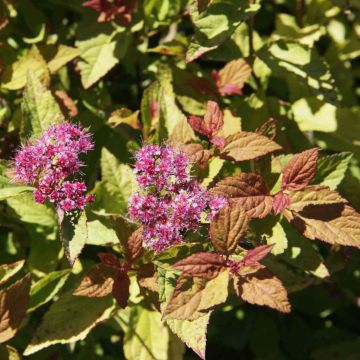

Cytisus scoparius Apricot Gem


Cytisus scoparius Apricot Gem


Cytisus scoparius Apricot Gem


Cytisus scoparius Apricot Gem


Cytisus scoparius Apricot Gem


Cytisus scoparius Apricot Gem
Cytisus scoparius Apricot Gem
Cytisus scoparius Apricot Gem
Common Broom, Scotch Broom, European Broom
Always satisfied with the quality of the young plants, the broom has just been planted. I live at an altitude of 900m (2953ft), so it is ideal for a fairly cold climate.
Betty, 08/03/2023
Special offer!
Receive a €20 voucher for any order over €90 (excluding delivery costs, credit notes, and plastic-free options)!
1- Add your favorite plants to your cart.
2- Once you have reached €90, confirm your order (you can even choose the delivery date!).
3- As soon as your order is shipped, you will receive an email containing your voucher code, valid for 3 months (90 days).
Your voucher is unique and can only be used once, for any order with a minimum value of €20, excluding delivery costs.
Can be combined with other current offers, non-divisible and non-refundable.
Home or relay delivery (depending on size and destination)
Schedule delivery date,
and select date in basket
This plant carries a 24 months recovery warranty
More information
We guarantee the quality of our plants for a full growing cycle, and will replace at our expense any plant that fails to recover under normal climatic and planting conditions.
Would this plant suit my garden?
Set up your Plantfit profile →
Description
Cytisus 'Apricot Gem', sometimes called Broom, is a medium-sized bushy shrub with numerous upright branches. Featuring a generous colourful flowering in June-July, this broom reveals soft colours in a variety of shades ranging from golden-yellow to red-orange. Hardy, drought-resistant, and easy to maintain, this broom has everything to charm the most demanding gardeners. It will even find its place in a container on a terrace, or a balcony, where it will provide glorious colour.
Resulting from hybridisation, the 'Apricot Gem' variety is characterised by its medium size, about 1.5 m (4.9 ft) in height and spread. With its bushy habit, dense and upright branches, this robust shrub has a graceful silhouette. Its numerous branches are rigid, angular, pubescent, and slender. They remain green throughout the year and bear deciduous foliage composed of small alternate leaves about 2 cm (0.8 in) long, which are simple or trifoliate.
In June and July, Cytisus 'Apricot Gem' is covered with a multitude of small multicoloured butterfly-like flowers, which are golden-yellow edged with red at the centre, and topped with apricot-orange petals. This slightly scented flowering attracts butterflies and bees. It occurs on the previous year's wood. Therefore, be careful with severe pruning that could compromise the appearance of the flowers. A fruiting, in the form of black pods, then takes over. It is advisable to remove them in order not to unnecessarily tire the shrub. Broom species are so named because their dry branches were once used to make brooms. Do not hesitate to keep the pruned branches to make a very effective tool for cleaning your outdoor spaces. Also note the ability of Cytisus scoparius to fix nitrogen and thus improve soil quality.
Like all brooms, Cytisus 'Apricot Gem' is very hardy but has a short lifespan of about 5 years. This species is found in dry places, on rather acidic and siliceous soils. It appreciates sunny exposures, and poor and well-drained soils, which are neutral or slightly acidic. However, it tolerates weakly calcareous soils. Choose its location carefully as it does not tolerate transplanting well. Cytisus scoparius has excellent hardiness, allowing it to withstand temperatures below -15° C (5° F). Plant in sandy soil without adding fertiliser. If your soil is heavy, lighten it with turf, sand, or gravel. Water it regularly during the first two years of planting. Once established, it has good drought tolerance.
Thanks to its medium size and dense upright silhouette, Cytisus 'Apricot Gem' can be used in multiple ways. It will find its place in a varied hedge, a flower bed, or a rock garden. Pair it with sun-loving, dry and poor soil shrubs with staggered flowering. Accompanied by a Montpellier Rockrose for its evergreen foliage and spring flowering, or an 'Atlantic' Strawberry Tree for its compact habit and beautiful red berries in autumn, it will contribute to creating a colourful and lively scene. It is also suitable for container gardening, allowing you to enjoy its beautiful peach-coloured flowering on your patio or balcony!
Report an error about the product description
Cytisus scoparius Apricot Gem in pictures






Plant habit
Flowering
Foliage
Botanical data
Cytisus
scoparius
Apricot Gem
Fabaceae
Common Broom, Scotch Broom, European Broom
Cultivar or hybrid
Planting and care
It appreciates sunny exposures, poor and well-drained, neutral or slightly acidic soils. However, it tolerates weakly calcareous soils. Choose its location carefully as it does not tolerate transplantations well.
Plant in sandy soil, without adding fertilisers. Lighten heavy soil with turf, sand or gravel. Water regularly during the summer for the first two years after planting. Once established, it has good drought tolerance.
Prune after flowering to remove its fruits and maintain a dense and bushy habit.
It is quite resistance to diseases. Easy to maintain, this little, undemanding young plant will find its place in most gardens!
Cytisus have a fairly short lifespan of about 5 years.
Planting period
Intended location
Care
-
, onOrder confirmed
Reply from on Promesse de fleurs
Similar products
Haven't found what you were looking for?
Hardiness is the lowest winter temperature a plant can endure without suffering serious damage or even dying. However, hardiness is affected by location (a sheltered area, such as a patio), protection (winter cover) and soil type (hardiness is improved by well-drained soil).

Photo Sharing Terms & Conditions
In order to encourage gardeners to interact and share their experiences, Promesse de fleurs offers various media enabling content to be uploaded onto its Site - in particular via the ‘Photo sharing’ module.
The User agrees to refrain from:
- Posting any content that is illegal, prejudicial, insulting, racist, inciteful to hatred, revisionist, contrary to public decency, that infringes on privacy or on the privacy rights of third parties, in particular the publicity rights of persons and goods, intellectual property rights, or the right to privacy.
- Submitting content on behalf of a third party;
- Impersonate the identity of a third party and/or publish any personal information about a third party;
In general, the User undertakes to refrain from any unethical behaviour.
All Content (in particular text, comments, files, images, photos, videos, creative works, etc.), which may be subject to property or intellectual property rights, image or other private rights, shall remain the property of the User, subject to the limited rights granted by the terms of the licence granted by Promesse de fleurs as stated below. Users are at liberty to publish or not to publish such Content on the Site, notably via the ‘Photo Sharing’ facility, and accept that this Content shall be made public and freely accessible, notably on the Internet.
Users further acknowledge, undertake to have ,and guarantee that they hold all necessary rights and permissions to publish such material on the Site, in particular with regard to the legislation in force pertaining to any privacy, property, intellectual property, image, or contractual rights, or rights of any other nature. By publishing such Content on the Site, Users acknowledge accepting full liability as publishers of the Content within the meaning of the law, and grant Promesse de fleurs, free of charge, an inclusive, worldwide licence for the said Content for the entire duration of its publication, including all reproduction, representation, up/downloading, displaying, performing, transmission, and storage rights.
Users also grant permission for their name to be linked to the Content and accept that this link may not always be made available.
By engaging in posting material, Users consent to their Content becoming automatically accessible on the Internet, in particular on other sites and/or blogs and/or web pages of the Promesse de fleurs site, including in particular social pages and the Promesse de fleurs catalogue.
Users may secure the removal of entrusted content free of charge by issuing a simple request via our contact form.
The flowering period indicated on our website applies to countries and regions located in USDA zone 8 (France, the United Kingdom, Ireland, the Netherlands, etc.)
It will vary according to where you live:
- In zones 9 to 10 (Italy, Spain, Greece, etc.), flowering will occur about 2 to 4 weeks earlier.
- In zones 6 to 7 (Germany, Poland, Slovenia, and lower mountainous regions), flowering will be delayed by 2 to 3 weeks.
- In zone 5 (Central Europe, Scandinavia), blooming will be delayed by 3 to 5 weeks.
In temperate climates, pruning of spring-flowering shrubs (forsythia, spireas, etc.) should be done just after flowering.
Pruning of summer-flowering shrubs (Indian Lilac, Perovskia, etc.) can be done in winter or spring.
In cold regions as well as with frost-sensitive plants, avoid pruning too early when severe frosts may still occur.
The planting period indicated on our website applies to countries and regions located in USDA zone 8 (France, United Kingdom, Ireland, Netherlands).
It will vary according to where you live:
- In Mediterranean zones (Marseille, Madrid, Milan, etc.), autumn and winter are the best planting periods.
- In continental zones (Strasbourg, Munich, Vienna, etc.), delay planting by 2 to 3 weeks in spring and bring it forward by 2 to 4 weeks in autumn.
- In mountainous regions (the Alps, Pyrenees, Carpathians, etc.), it is best to plant in late spring (May-June) or late summer (August-September).
The harvesting period indicated on our website applies to countries and regions in USDA zone 8 (France, England, Ireland, the Netherlands).
In colder areas (Scandinavia, Poland, Austria...) fruit and vegetable harvests are likely to be delayed by 3-4 weeks.
In warmer areas (Italy, Spain, Greece, etc.), harvesting will probably take place earlier, depending on weather conditions.
The sowing periods indicated on our website apply to countries and regions within USDA Zone 8 (France, UK, Ireland, Netherlands).
In colder areas (Scandinavia, Poland, Austria...), delay any outdoor sowing by 3-4 weeks, or sow under glass.
In warmer climes (Italy, Spain, Greece, etc.), bring outdoor sowing forward by a few weeks.








































